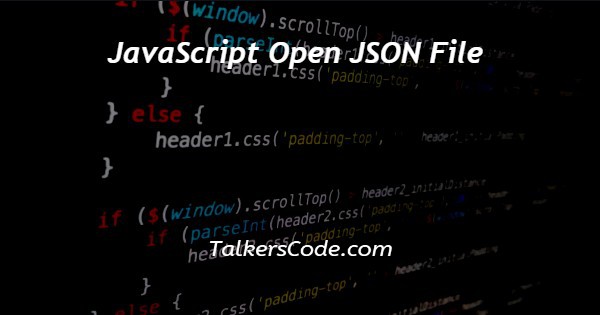In this article we will show you the solution of JavaScript open JSON file, a powerful programming language called JavaScript is frequently used to create interactive web apps. A key feature of JavaScript is its wonderful conformance with JSON (JavaScript Object Notation) files.
JSON is a basic statistics format for shifting facts between servers and net packages.
When it involves starting a JSON file, JavaScript's integrated features are useful.
With the XMLHttpRequest or Fetch API, you could provoke an HTTP request to achieve the ideal JSON document from a server.
After the record has been retrieved, the JSON string can be transformed right into a JavaScript object the use of the JSON.Parse() approach.
Now move to the concept of javascript open json file.
Step By Step Guide On JavaScript Open JSON File :-
<!DOCTYPE html>
<html>
<head>
<title>Open JSON File</title>
</head>
<body>
<button onclick="openJSONFile('data.json')">Open JSON File</button>
<script>
function openJSONFile(fileUrl) {
var xhr = new XMLHttpRequest();
xhr.open("GET", fileUrl, true);
xhr.responseType = "json";
xhr.onload = function() {
if (xhr.status === 200) {
var jsonResponse = xhr.response;
processJSONData(jsonResponse);
} else {
console.error("Failed to open JSON file: " + fileUrl);
}
};
xhr.send();
}
function processJSONData(jsonData) {
console.log("JSON data:", jsonData);
}
</script>
</body>
</html>
- We have a single "Open JSON File" button in our HTML content.
- This button activates the openJSONFile function when users click it.
- The JSON file supplied by its URL can be fetched and obtained using this function.
- We construct a fresh XMLHttpRequest object, xhr, within the openJSONFile function in order to send an HTTP request.
- We add the file URL argument and provide the GET HTTP method.
- We ensure that the expected response will be in JSON format by setting xhr.responseType to "json".
- We connect an onload event listener to xhr in order to manage the request's completion.
- We determine whether the response's status is 200, which denotes a successful request, inside this event listener.
- If so, we use xhr.response to extract the JSON data from the response and provide it to the method processJSONData for additional processing.
- If the status is not 200, on the other hand, we record a console error message alerting us that the JSON file could not be opened.
- The openJSONFile function passes the JSON data it has received to the processJSONData function.
- We have the freedom to access and modify the JSON data as necessary within this function.
- In the instance given, we merely use console.Log("JSON information:", jsonData) to log the JSON statistics to the console.
- This process enables us to carry out any additional tasks needed for our utility as well as allows us to verify that the JSON facts has been successfully obtained.
Conclusion :-
As a result, we were able to understand the idea of javascript open json file.
We also discovered that web applications may easily communicate with JSON files thanks to JavaScript's interoperability with JSON.
JSON files can be downloaded from servers using built-in functions like XMLHttpRequest or the Fetch API, and then converted into JavaScript objects using JSON.parse().
I hope this article on JavaScript open JSON file helps you and the steps and method mentioned above are easy to follow and implement.














